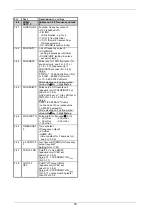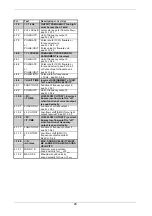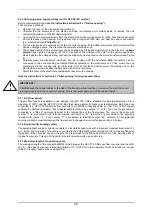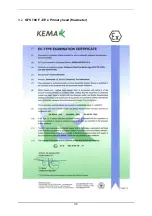
28
8.3.6 Changing power supply voltage (not for 24 VAC/DC version)
Before commencing work,
note the instructions in Section 2.3 ("Before opening")
.
Then continue as follows:
1. Remove the cover of the electronics compartment.
2. Unscrew the two screws
A
of the display unit and turn display unit carefully aside or remove the unit
completely by taking out the flat cable connector.
3. Unscrew the two mounting screws
B
of the electronics unit as well as screw
C
, which fixes the copper earth
strip at the back of the housing. A screwdriver with a long shaft (200 mm) can best be used to unscrew
C
(e.g. screwdriver type
Philips No. 2
).
4. Pull the electronics unit carefully out of the converter housing, till the SMB connectors of the coaxial cables
can be unplugged easily. Then remove the complete electronics unit.
5. The voltage setting of the power supply can be changed by turning the dummy dual-in-line block (i.e.
voltage
selector
, see Figure 6 on page 6) over 180° in its socket. The position of the notch on the dummy dual-in-line
block indicates the voltage setting. Also see the sticker that is mounted on the mains transformer (see Figure
6).
6. Carefully insert the electronics unit back into the housing until the numbered SMB connectors can be
connected to the corresponding numbered SMB receptacles on the electronics unit. Then mount the unit
completely into the housing and fix the screws. First
C
, then
B
and finally screw the display unit on the
electronics via screws
A
, after the flat cable connector is connected.
7. Screw the cover of the electronics compartment back into the housing.
Note the instructions of section 2.3 ("After opening") during reassembling.
IMPORTANT !
Carefully keep the coaxial cables to the side of the housing, while inserting or removing the electronics unit
into respectively from the converter housing. This is to prevent damaging of the coaxial cables !
8.3.7 Gas flow sensor
The gas flow sensor is available in two designs, the GFS 700 F-EEx (standard) for gas temperatures up to a
maximum of 180°C and the GFS 700 F/HT-EEx (high-temperature) for higher gas temperatures. Both types are
connected to a GFC 700 F-EEx gas flow converter via a MR04 connecting cable (i.e. four RG 179 B/U coaxial
cables with additional insulation). Each coaxial cable is marked by a number "1" to "4". The core of each cable is
connected to a "EEx e" approved terminal in the terminal box of the flow sensor. The core of the cable with
number "1" is connected to the terminal marked with number "21", the screen is connected to the adjoining
terminal with number "1". Core number "2" is connected to terminal number "22", etcetera. An equipotential
bonding conductor must interconnect the flow sensor to the gas flow converter (see section 2.5 below).
8.3.8 Equipotential bonding system
The equipotential bonding conductor consists of a insulated copper wire with a minimum cross-sectional area of 4
mm
2
(AWG 10). One side of the wire is connected to the external M5 clamp terminal on the connecting flange at
the bottom of the converter housing, the other end is screwed to the M8 bolt/nut terminal on the warning plate of
the gas flow sensor. This end of the cable is therefor provided with a eye cable tag.
8.3.9 Maximum length of connecting cable
The maximum length of the connecting MR04 cable between the GFC 700 F-EEx gas flow converter and the GFS
700 F/…-EEx gas flow sensor is standard limited at 10 m (30 ft) due to measurement technical reasons. Longer
cables on request, but must be evaluated first.
Summary of Contents for GFM 700 F
Page 31: ...31 9 ATEX approvals 9 1 GFC 700 F EEx Signal converter...
Page 32: ...32...
Page 33: ...33...
Page 34: ...34 9 2 GFS 700 F EEx Primary head flowmeter...
Page 35: ...35...
Page 36: ...36...









































